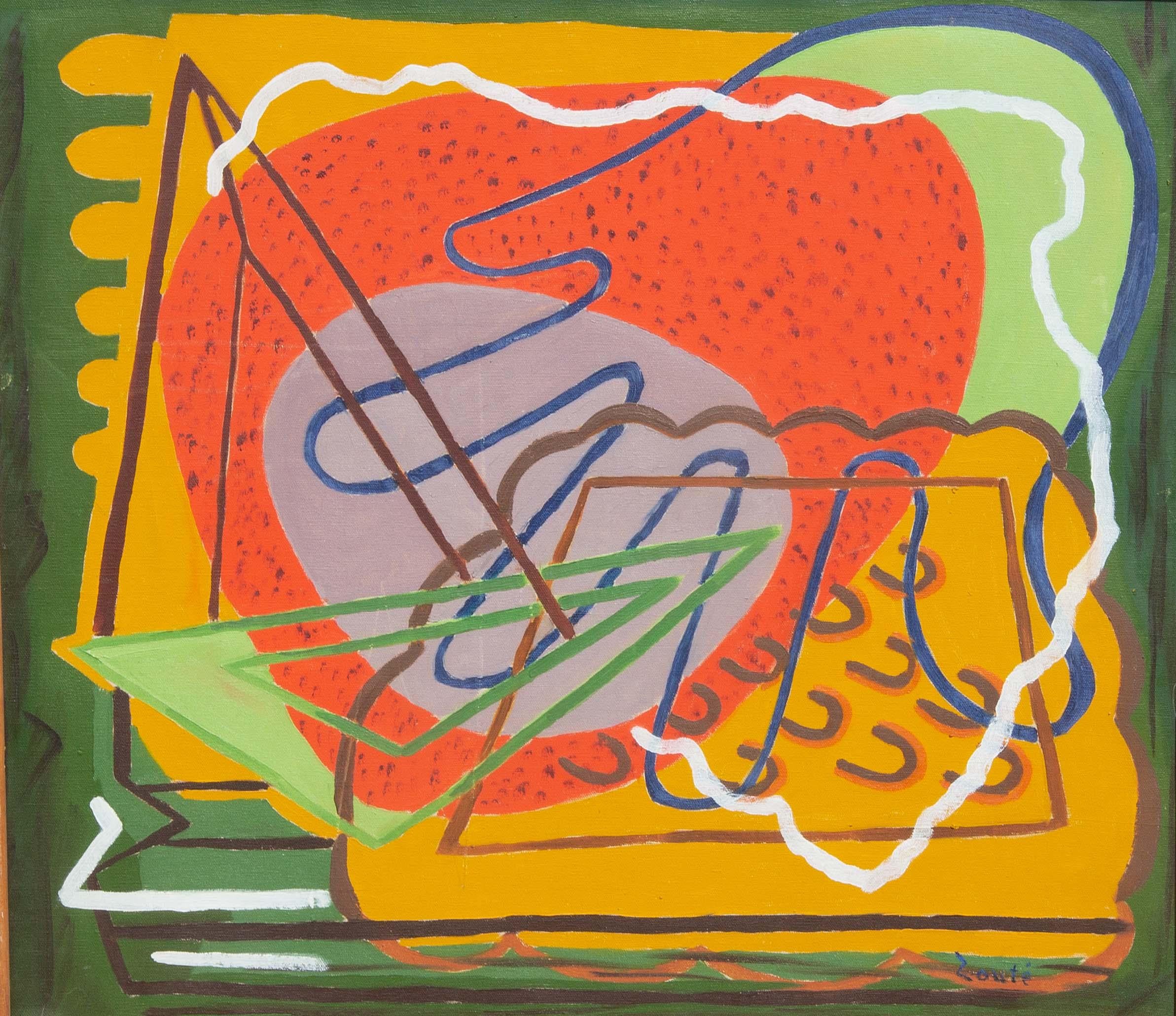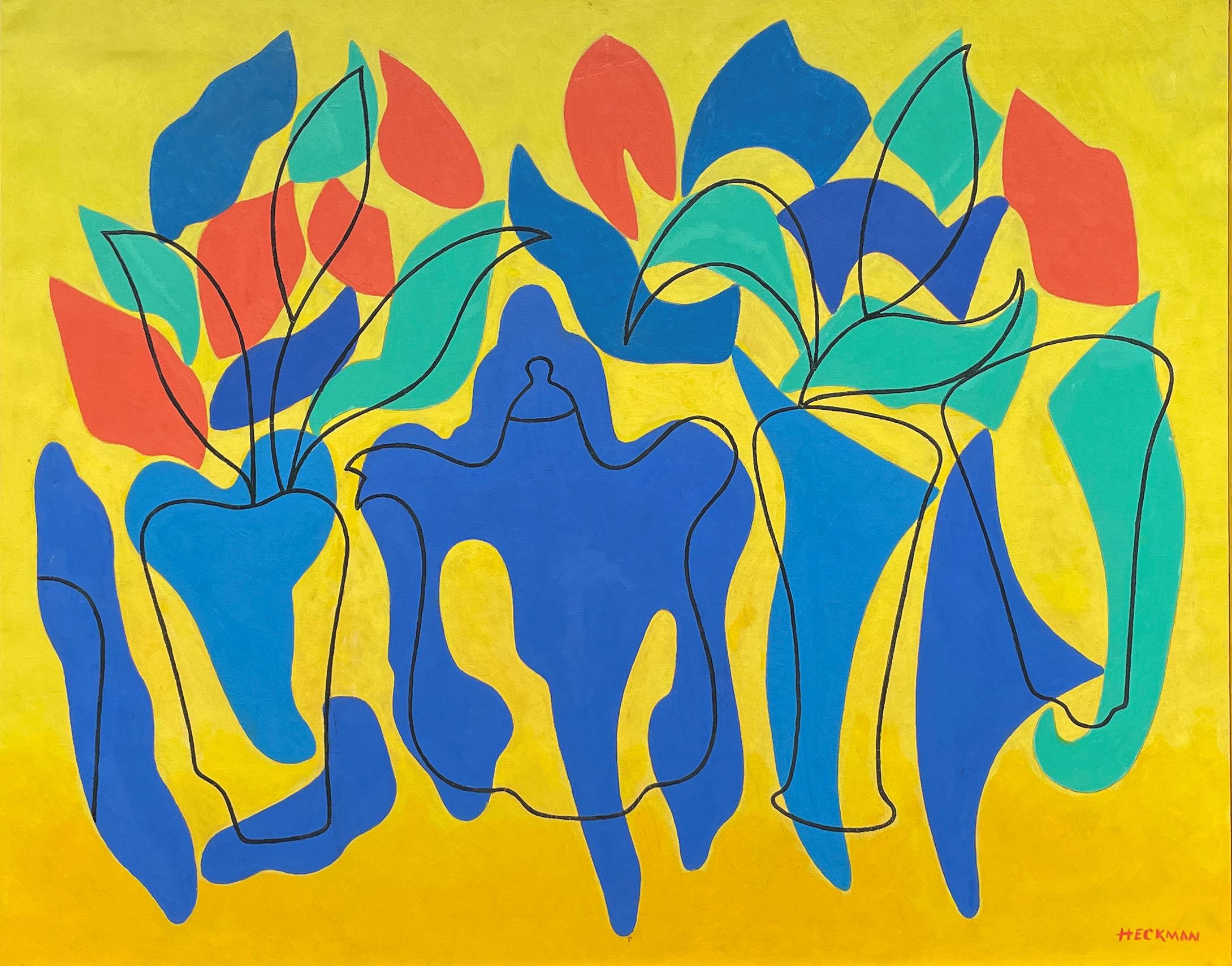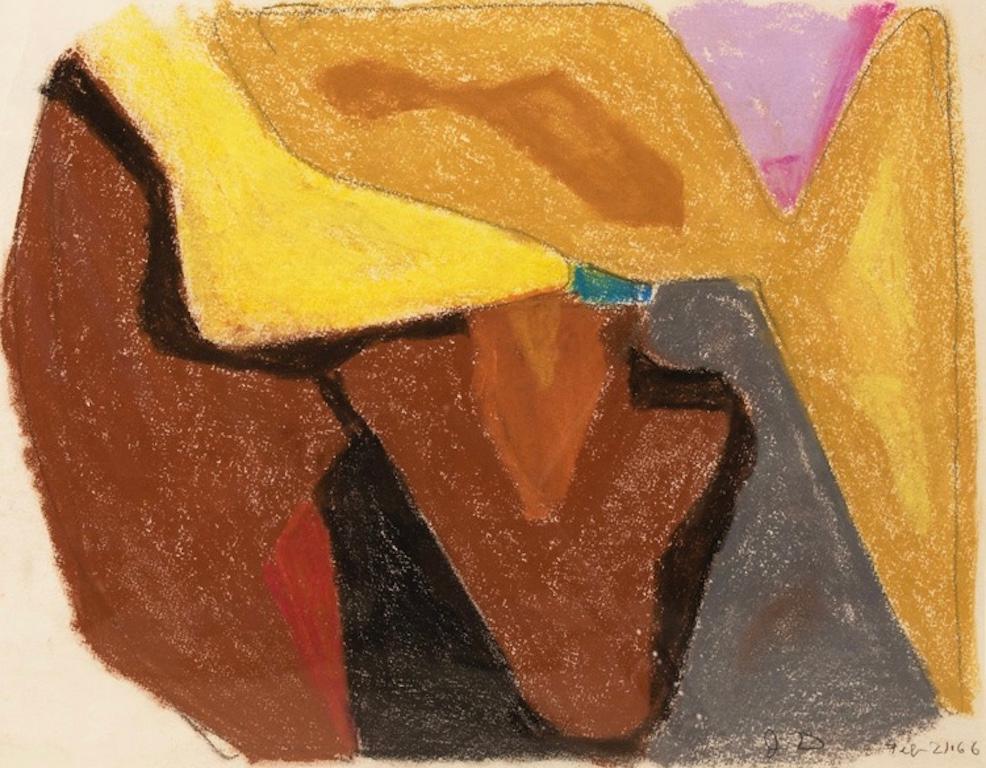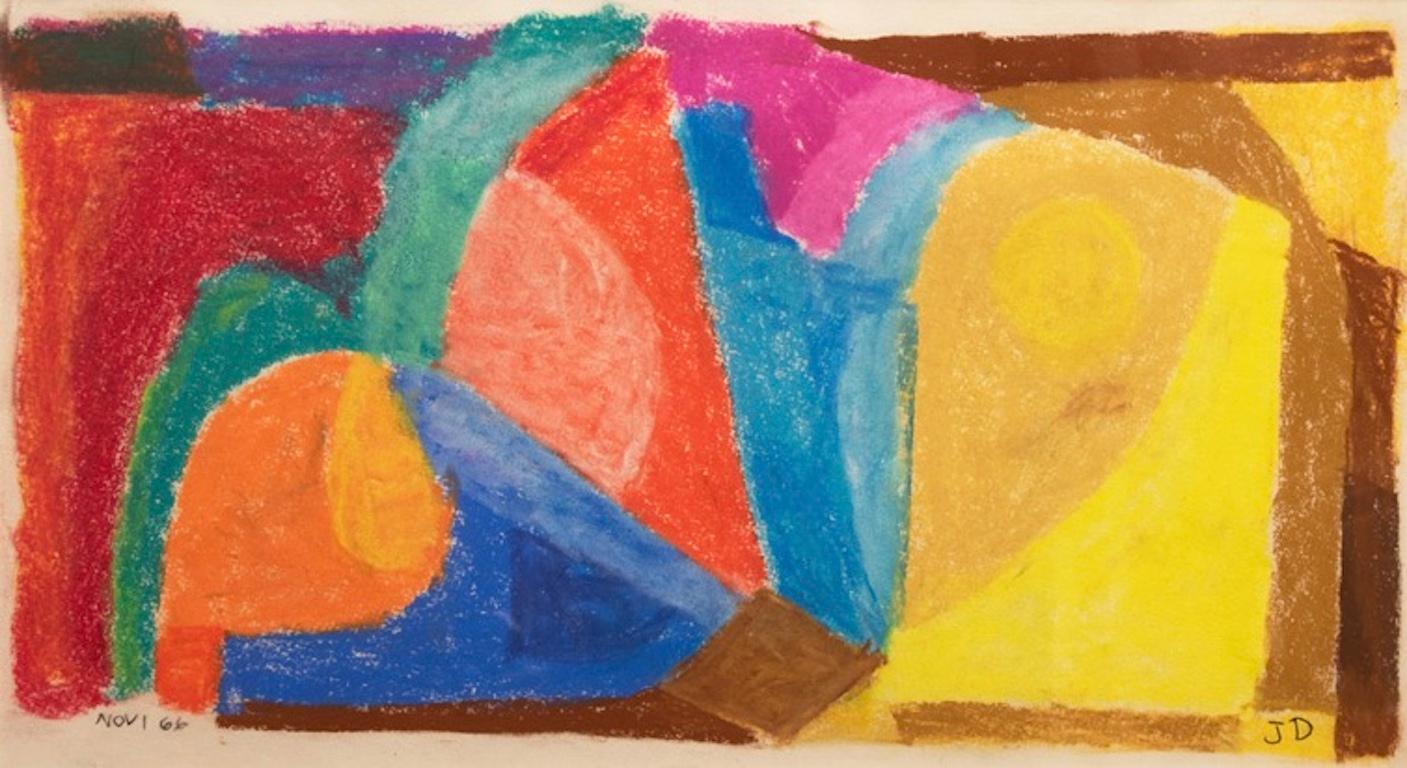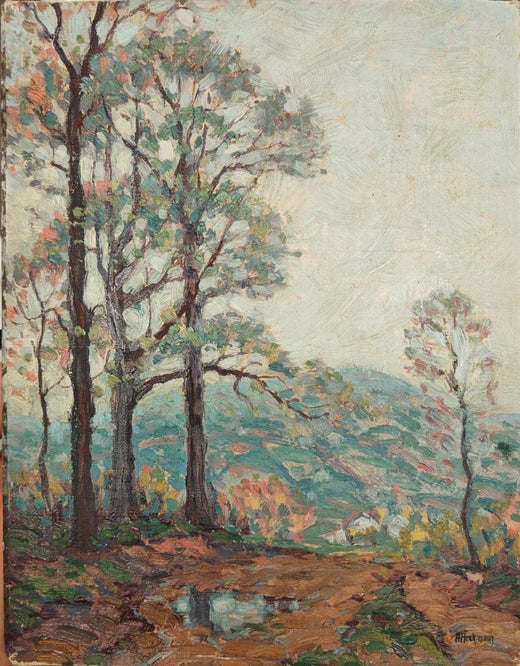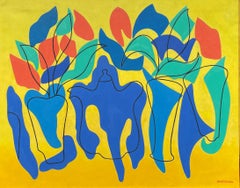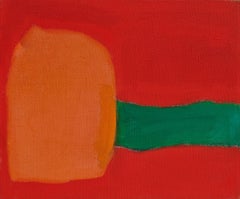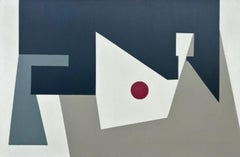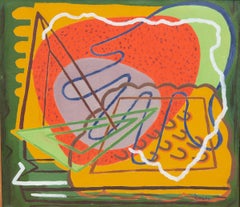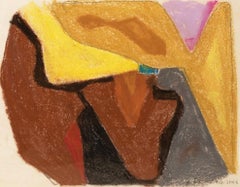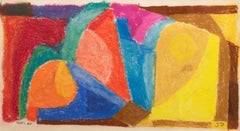Items Similar to "Untitled" Albert Heckman, Mid-Century American Modernist Abstract Composition
Want more images or videos?
Request additional images or videos from the seller
1 of 9
Albert Heckman"Untitled" Albert Heckman, Mid-Century American Modernist Abstract Compositioncirca 1950
circa 1950
$6,000
£4,671.29
€5,312.01
CA$8,626.29
A$9,473.34
CHF 4,947.16
MX$113,068.29
NOK 62,675.75
SEK 58,416.26
DKK 39,673.82
About the Item
Albert Heckman
Untitled
Signed lower left
Oil on canvas
20 x 24 inches
Albert Heckman was born in Meadville, Western Pennsylvania, 1893. He went to New York City to try his hand at the art world in 1915 after graduating from high school and landing a job at the Meadville Post Office. In 1917, at the age of 24, Heckman enrolled part-time in Teachers' College, Columbia University's Fine Arts Department to begin his formal art education. He worked as a freelance ceramic and textile designer and occasionally as a lecturer at the Metropolitan Museum of Art. In the early 1920s, at the age of almost 30, he graduated with a Bachelor of Arts degree from Columbia Teachers College. He was especially impacted by his instructor at Columbia, Arthur Wesley Dow.
After graduating, he was hired by the Teachers' College as a Fine Arts instructor. He stayed with Columbia Teachers' College until 1929, when he left to attend the Leipzig Institute of Graphic Arts in Leipzig, Germany. Isami Doi (1903-1965), who was born in Hawaii, was arguably his most impressive student at Columbia. Doi is now regarded as one of the most prominent artists hailing from Hawaii. Heckman became an active member and officer of the Keramic Society and Design Guild of New York in the 1920s as part of his early commercial art career. The Society's mission was to share knowledge and showcase textile and ceramic design exhibits.
In 1922, Heckman married Florence Hardman, a concert violinist. Mrs. Heckman's concert schedule during the 1920s kept Albert and Florence Heckman apart for a significant portion of the time, but they spent what little time they had together designing and building their Woodstock, New York, summer house and grounds. A small house and an acre of surrounding land on Overlook Mountain, just behind the village of Woodstock, were purchased by Albert and Florence Heckman at the time of their marriage. Their Woodstock home, with its connections, friendships, and memories, became a central part of their lives over the years, even though they had an apartment in New York City.
Heckman's main artistic focus shifted to the house on Overlook Mountain and the nearby towns and villages, Kingston, Eddyville, and Glasco. After returning from the Leipzig Institute of Graphic Arts in 1930, Mr. Heckman joined Hunter College as an assistant professor of art. He worked there for almost thirty years, retiring in 1956. Throughout his tenure at Hunter, Mr. Heckman and his spouse spent the summers at their Woodstock residence and the winters in New York City. They were regular and well-known guests at the opera and art galleries in New York. Following his retirement in 1956, the Heckmans settled in Woodstock permanently, with occasional trips to Florida or Europe during the fall and winter. Mr. Heckman's close friends and artistic career were always connected to Woodstock or New York City. He joined the Woodstock art group early on and was greatly influenced by artists like Paul and Caroline Rohland, Emil Ganso, Yasuo Kuniyoshi, Andre Ruellan, and her husband, Jack Taylor.
Heckman operated a summer art school in Woodstock for several years in the 1930s with support from Columbia University, where these and other Woodstock artists gave guest lectures. The Potter's Shop in New York City hosted Mr. Heckman's first art show in December 1928. The exhibit received some positive reviews from critics. The American Institute of Graphic Arts chose the plate of "Wehlen, Saxony" as one of the "Fifty Prints of the Year in 1929." There were sixteen etchings displayed. The remaining plates depicted scenes in Saxony, Germany, while five of the plates were based on scenes in Rondout, New York.
Heckman started switching from etching to black and white lithography by the early 1930s. A lifelong admirer of Heckman's artwork, Mr. Gustave von Groschwitz organized a significant exhibition of Heckman etchings and lithographs at the Ferargil Gallery in New York City in 1933. The exhibition traveled to the Stendahl Galleries in Los Angeles (May 1933), the Charles Lessler Gallery in Philadelphia (May 1933), J.L. Hudson in Detroit (June 1933), and Gumps in San Francisco (July 1933). Together with his early etchings, the exhibition featured brand-new black and white lithographs depicting scenes in and around Woodstock as well as "A View from Tudor City," a black and white lithograph of a scene of 42nd Street in New York City. The exhibit was briefly mentioned in the New York Times and on April 23, 1933: "Mr. Heckman's work is strong and original as witness the "Rondout Bridge" etching which is scarcely more than an angle and reverse curves done with great sweep."
In 1935, von Groschwitz again arranged for a Heckman exhibition at the Ferargil Gallery. The exhibition consisted of black and white lithographs and pen and pencil drawings. The Herald Tribune wrote of these works, "His studies of trees drawn with lyrical feeling are notable." Despite modest sales and comparatively positive reviews from Times and Tribune critics, Mr. Heckrnan's formal one-man shows came to an end with the second exhibit at the Ferargil Gallery. He was to limit himself to showcasing individual pieces at both domestic and international exhibitions following his 1935 Ferargil Show.
Gertrude Vanderbilt Whitney was a significant influence on the Woodstock art scene in the early 1930s, first through her Greenwich Village Studio Club and then through the Whitney to promote American contemporary art. Mr. Heckman knew Herman More, the curator of the Whitney Museum, and Juliana Force, its first director, both of whom lived in Woodstock. From the First Biennial Exhibition of American Sculpture, Watercolor and Prints in December 1933 to the annual Exhibition of Sculpture, Watercolor and Drawings in 1956, Mr. Heckman displayed his work at Whitney exhibitions for nearly 25 years, in part because of these connections. Mr. Heckman' s major lithographs and prints made during the 1930s include the black and white lithographs "Bridge at Poughkeepsie," "Loading Lumber," “Oil
Yards at Rondout," "Car Barns at Kingston”, “Old Locks at Eddyville”, "Crossroads," "Stoney Hollow Railroad Station, "Rip Van Winkle Bridge," "Sudden Rain," and "Deserted Village”. In addition to his participation at the Whitney during the 1930's, Heckman presented lectures, using his work for illustrative purposes, at several colleges and universities on the object of etching and lithography. He actively participated in the Federal Art Projects during the 1930s Depression and created "Sudden Rain" and "Stoney Hollow Railway Station" as part of these initiatives. His black and white lithographs "Wind and Rain" and "Windblown Trees," as well as the roulette drypoint "Deserted Village," were featured in the first catalogues produced by the Associated American Artists, an organization of which Heckman was a founding member.
Heckman’s style had matured by the 1930s, transitioning from his early stiff etchings to more poetic black and white lithographs and drawings. He switched from etchings and black-and-white lithographs, which had been his primary mediums, to oils and watercolors in the late 1930s and early 1940s. Heckman's oil painting, "Eddyville, New York," was displayed in the Carnegie Institute's October–December 1941 Directions in American Painting exhibit in Pittsburgh. In 1942, his oil painting "Glasco Landscape" was displayed in the Metropolitan Museum of Art's Artists for Victory: An Exhibition of Contemporary American Art. Heckman finished a number of watercolor paintings of scenes in the Woodstock and Kingston, New York, areas in the 1940s.
In the 1950s, he painted a series of abstract watercolor designs that would serve as the foundation for a number of color lithographs. The Cincinnati Art Museum's Curator of Prints, Gustave von Groschwitz, began a series of international color lithography exhibitions in the 1950s. The color lithograph "Fruit Forms," which was displayed at the Whitney's Annual Exhibition of Contemporary American Sculpture, Watercolor and Prints in January 1937, is currently part of the Whitney permanent collection.
In 1958, Heckman retired from Hunter College, and the Heckmans relocated from New York City to Woodstock as their permanent residence. He mostly created abstract designs in oils, watercolors, and inks while he was retired. He didn't have many exhibitions in the 1960s. Appropriately, his final public display took place at an exhibition honoring the 50th anniversary of the Woodstock Artists Association in Woodstock, New York. The lithographer, painter, etcher, and teacher Albert Heckman cherished Woodstock and New York. With the intention of preserving the Woodstock art scene and way of life that he and his wife, Florence, had helped to create, he left money to the Woodstock Art Association in his will. He is buried in the Artists' Cemetery in Woodstock, New York, alongside his wife, Florence, after passing away in Kingston, New York, in February 1971.
- Creator:Albert Heckman (1893-1971, American)
- Creation Year:circa 1950
- Dimensions:Height: 27.5 in (69.85 cm)Width: 31.25 in (79.38 cm)
- More Editions & Sizes:Unique workPrice: $6,000
- Medium:
- Movement & Style:
- Period:
- Condition:
- Gallery Location:New York, NY
- Reference Number:1stDibs: LU1841216726062
Albert Heckman
Born in Meadville, Pennsylvania, Heckman came to NYC in 1915 and divided his time between there and Woodstock for the rest of his life except for 1929, when he studied in Leipzig. Married to concert violinist Florence Hardeman. Position: teacher, Hunter College, 1930-58; Teachers College Summer School, Woodstock, 1930s. Author: Paintings of Many Lands and Ages. He was a member of the Woodstock Art Association; and was also part of the Works Progress Administration Federal Arts Program in New York City, doing etching and block printing. He was influenced by Cubism and Expressionism.
About the Seller
5.0
Platinum Seller
Premium sellers with a 4.7+ rating and 24-hour response times
Established in 2022
1stDibs seller since 2022
131 sales on 1stDibs
Typical response time: <1 hour
- ShippingRetrieving quote...Shipping from: New York, NY
- Return Policy
More From This Seller
View All"Untitled" Albert Heckman, 1950s Modernist Abstracted Still Life Painting
By Albert Heckman
Located in New York, NY
Albert Heckman
Untitled, circa 1950
Signed lower right
Oil on canvas
21 1/4 x 29 inches
Albert Heckman was born in Meadville, Western Pennsylvania, 1893. He went to New York City to try his hand at the art world in 1915 after graduating from high school and landing a job at the Meadville Post Office. In 1917, at the age of 24, Heckman enrolled part-time in Teachers' College, Columbia University's Fine Arts Department to begin his formal art education. He worked as a freelance ceramic and textile designer and occasionally as a lecturer at the Metropolitan Museum of Art. In the early 1920s, at the age of almost 30, he graduated with a Bachelor of Arts degree from Columbia Teachers College. He was especially impacted by his instructor at Columbia, Arthur Wesley Dow.
After graduating, he was hired by the Teachers' College as a Fine Arts instructor. He stayed with Columbia Teachers' College until 1929, when he left to attend the Leipzig Institute of Graphic Arts in Leipzig, Germany. Isami Doi (1903-1965), who was born in Hawaii, was arguably his most impressive student at Columbia. Doi is now regarded as one of the most prominent artists hailing from Hawaii. Heckman became an active member and officer of the Keramic Society and Design Guild of New York in the 1920s as part of his early commercial art career. The Society's mission was to share knowledge and showcase textile and ceramic design exhibits.
In 1922, Heckman married Florence Hardman, a concert violinist. Mrs. Heckman's concert schedule during the 1920s kept Albert and Florence Heckman apart for a significant portion of the time, but they spent what little time they had together designing and building their Woodstock, New York, summer house and grounds. A small house and an acre of surrounding land on Overlook Mountain, just behind the village of Woodstock, were purchased by Albert and Florence Heckman at the time of their marriage. Their Woodstock home, with its connections, friendships, and memories, became a central part of their lives over the years, even though they had an apartment in New York City.
Heckman's main artistic focus shifted to the house on Overlook Mountain and the nearby towns and villages, Kingston, Eddyville, and Glasco. After returning from the Leipzig Institute of Graphic Arts in 1930, Mr. Heckman joined Hunter College as an assistant professor of art. He worked there for almost thirty years, retiring in 1956. Throughout his tenure at Hunter, Mr. Heckman and his spouse spent the summers at their Woodstock residence and the winters in New York City. They were regular and well-known guests at the opera and art galleries in New York. Following his retirement in 1956, the Heckmans settled in Woodstock permanently, with occasional trips to Florida or Europe during the fall and winter. Mr. Heckman's close friends and artistic career were always connected to Woodstock or New York City. He joined the Woodstock art group early on and was greatly influenced by artists like Paul and Caroline Rohland, Emil Ganso, Yasuo Kuniyoshi, Andre Ruellan, and her husband, Jack Taylor.
Heckman operated a summer art school in Woodstock for several years in the 1930s with support from Columbia University, where these and other Woodstock artists gave guest lectures. The Potter's Shop in New York City hosted Mr. Heckman's first art show in December 1928. The exhibit received some positive reviews from critics. The American Institute of Graphic Arts chose the plate of "Wehlen, Saxony" as one of the "Fifty Prints of the Year in 1929." There were sixteen etchings displayed. The remaining plates depicted scenes in Saxony, Germany, while five of the plates were based on scenes in Rondout, New York.
Heckman started switching from etching to black and white lithography by the early 1930s. A lifelong admirer of Heckman's artwork, Mr. Gustave von Groschwitz organized a significant exhibition of Heckman etchings and lithographs at the Ferargil Gallery in New York City in 1933. The exhibition traveled to the Stendahl Galleries in Los Angeles (May 1933), the Charles Lessler Gallery in Philadelphia (May 1933), J.L. Hudson in Detroit (June 1933), and Gumps in San Francisco (July 1933). Together with his early etchings, the exhibition featured brand-new black and white lithographs depicting scenes in and around Woodstock as well as "A View from Tudor City...
Category
1950s American Modern Figurative Paintings
Materials
Canvas, Oil
"Untitled" Albert Heckman, Still Life, Floral Abstracted Modernist Composition
By Albert Heckman
Located in New York, NY
Albert Heckman
Untitled, circa 1950
Signed lower right
Oil on canvas
25 1/4 x 32 1/4 inches
Albert Heckman was born in Meadville, Western Pennsylvania, 1893. He went to New York City to try his hand at the art world in 1915 after graduating from high school and landing a job at the Meadville Post Office. In 1917, at the age of 24, Heckman enrolled part-time in Teachers' College, Columbia University's Fine Arts Department to begin his formal art education. He worked as a freelance ceramic and textile designer and occasionally as a lecturer at the Metropolitan Museum of Art. In the early 1920s, at the age of almost 30, he graduated with a Bachelor of Arts degree from Columbia Teachers College. He was especially impacted by his instructor at Columbia, Arthur Wesley Dow.
After graduating, he was hired by the Teachers' College as a Fine Arts instructor. He stayed with Columbia Teachers' College until 1929, when he left to attend the Leipzig Institute of Graphic Arts in Leipzig, Germany. Isami Doi (1903-1965), who was born in Hawaii, was arguably his most impressive student at Columbia. Doi is now regarded as one of the most prominent artists hailing from Hawaii. Heckman became an active member and officer of the Keramic Society and Design Guild of New York in the 1920s as part of his early commercial art career. The Society's mission was to share knowledge and showcase textile and ceramic design exhibits.
In 1922, Heckman married Florence Hardman, a concert violinist. Mrs. Heckman's concert schedule during the 1920s kept Albert and Florence Heckman apart for a significant portion of the time, but they spent what little time they had together designing and building their Woodstock, New York, summer house and grounds. A small house and an acre of surrounding land on Overlook Mountain, just behind the village of Woodstock, were purchased by Albert and Florence Heckman at the time of their marriage. Their Woodstock home, with its connections, friendships, and memories, became a central part of their lives over the years, even though they had an apartment in New York City.
Heckman's main artistic focus shifted to the house on Overlook Mountain and the nearby towns and villages, Kingston, Eddyville, and Glasco. After returning from the Leipzig Institute of Graphic Arts in 1930, Mr. Heckman joined Hunter College as an assistant professor of art. He worked there for almost thirty years, retiring in 1956. Throughout his tenure at Hunter, Mr. Heckman and his spouse spent the summers at their Woodstock residence and the winters in New York City. They were regular and well-known guests at the opera and art galleries in New York. Following his retirement in 1956, the Heckmans settled in Woodstock permanently, with occasional trips to Florida or Europe during the fall and winter. Mr. Heckman's close friends and artistic career were always connected to Woodstock or New York City. He joined the Woodstock art group early on and was greatly influenced by artists like Paul and Caroline Rohland, Emil Ganso, Yasuo Kuniyoshi, Andre Ruellan, and her husband, Jack Taylor.
Heckman operated a summer art school in Woodstock for several years in the 1930s with support from Columbia University, where these and other Woodstock artists gave guest lectures. The Potter's Shop in New York City hosted Mr. Heckman's first art show in December 1928. The exhibit received some positive reviews from critics. The American Institute of Graphic Arts chose the plate of "Wehlen, Saxony" as one of the "Fifty Prints of the Year in 1929." There were sixteen etchings displayed. The remaining plates depicted scenes in Saxony, Germany, while five of the plates were based on scenes in Rondout, New York.
Heckman started switching from etching to black and white lithography by the early 1930s. A lifelong admirer of Heckman's artwork, Mr. Gustave von Groschwitz organized a significant exhibition of Heckman etchings and lithographs at the Ferargil Gallery in New York City in 1933. The exhibition traveled to the Stendahl Galleries in Los Angeles (May 1933), the Charles Lessler Gallery in Philadelphia (May 1933), J.L. Hudson in Detroit (June 1933), and Gumps in San Francisco (July 1933). Together with his early etchings, the exhibition featured brand-new black and white lithographs depicting scenes in and around Woodstock as well as "A View from Tudor City...
Category
1950s Abstract Figurative Paintings
Materials
Canvas, Oil
"Untitled" Edward Zutrau, Mid Century Abstract Expressionist Colorist Painting
Located in New York, NY
Edward Zutrau
Untitled
Signed and dated on stretcher
Oil on linen
26 x 31 1/2 inches
Edward Zutrau is among the American artists who worked within the whirlwind of diverse abstract...
Category
Mid-20th Century Abstract Expressionist Abstract Paintings
Materials
Linen, Oil
"Composition" Balcomb Greene, Geometric Abstract, Early Modernist Composition
By Balcomb Greene
Located in New York, NY
Balcomb Greene
Composition, 1936
Signed Balcomb Greene on verso upper stretcher bar
Signed on backing board: Balcomb Greene
Oil on canvas
30 1/4 x 46 inches
Provenance:
The artist
A...
Category
1930s Abstract Abstract Paintings
Materials
Canvas, Oil
"Untitled" Seymour Franks, Mid-Century Abstract Swirling Composition
By Seymour Franks
Located in New York, NY
Seymour Franks
Untitled, circa 1948
Signed lower right
Mixed media on panel
15 1/4 x 22 1/2 inches
Seymour Franks, 1916-1981, originated from New York City, where he was born in 19...
Category
1940s Abstract Mixed Media
Materials
Mixed Media, Panel
"Untitled" Edward Zutrau, 1963 Post-Painterly Abstract Expressionist Painting
Located in New York, NY
Edward Zutrau
Untitled, 1963
Signed and dated on stretcher verso "5/63"
Oil on canvas
8 3/4 x 10 3/4 inches
Edward Zutrau is among the American artists who worked within the whirlw...
Category
1960s Abstract Expressionist Abstract Paintings
Materials
Canvas, Oil
You May Also Like
Abstract Composition by Zoute (Leon Salter) Mid Century
Located in Rochester, NY
Abstract Modernist oil painting by Zoute. Oil on canvas mounted on board. Painted in circa 1940's.
Zoute (Born-Leon Salter, 1903-1976) was self-taught and well exhibited during his l...
Category
Mid-20th Century Abstract Abstract Paintings
Materials
Canvas, Oil
"Untitled" Mid 20th Century American Abstract 1960s Color Field Abstraction
Located in New York, NY
"Untitled" Mid 20th Century American Abstract 1960s Color Field Abstraction
James Daugherty (1887 – 1974)
Untitled
12 ¼ x 15 ¼ inches
Initialed and dated February 21, 1966 lower ri...
Category
1960s Abstract Abstract Drawings and Watercolors
Materials
Paper, Pastel
Untitled (abstract expressionist mid-century modern painting)
By Joseph Fiore
Located in Wilton Manors, FL
Joseph Fiore (1928-2005) Untitled, ca. 1955. Oil on canvas, 18 x 24 inches.
Measuring 24 x 30 inches in custom modernist frame. Signed lower left. Excellent condition.
Joseph Albe...
Category
Mid-20th Century Abstract Expressionist Abstract Paintings
Materials
Canvas, Oil
$3,000 Sale Price
25% Off
"Untitled" Mid 20th Century American Abstract 1960s Color Field Abstraction
Located in New York, NY
"Untitled" Mid 20th Century American Abstract 1960s Color Field Abstraction
James Daugherty (1887 – 1974)
Untitled
9 x 16 inches
Initialed lower right
Dated November 1, 1966 lower ...
Category
1960s Abstract Abstract Drawings and Watercolors
Materials
Paper, Pastel
"Abstraction" Mid-20th Century American Abstract 1960s Color Field Modernist
Located in New York, NY
"Abstraction" Mid-20th Century American Abstract 1960s Color Field Modernist
James Daugherty (1887 – 1974)
"Abstraction"
58 ¼ x 41 ¾ inches
Signed and dated 1957 lower left
Oil on...
Category
1950s Abstract Abstract Paintings
Materials
Oil, Canvas
"Abstraction" Mid-20th Century American Abstract 1960s Color Field Modernist
Located in New York, NY
"Abstraction" Mid-20th Century American Abstract 1960s Color Field Modernist
James Daugherty (1887 – 1974)
Abstraction with White Border
16 x 12 inches
Estate stamp verso
Oil on p...
Category
1960s Abstract Abstract Paintings
Materials
Oil, Panel

